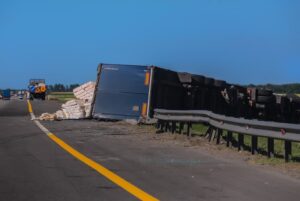We’ve all seen them on the roads of Southeast Missouri—the flatbed trucks carrying heavy machinery, the dump trucks filled with gravel for a construction project, the log haulers making their way through our rural areas. We trust that the loads they carry are secure. A falling cargo accident is the result of that trust being broken.
Falling cargo isn’t just about a massive container toppling off a trailer. It can be any material, equipment, or product that becomes dislodged from a commercial truck, turning into a dangerous projectile or a treacherous obstacle on the road. A Cape Girardeau truck accident attorney can help you pursue justice and compensation if you’ve been injured in such an incident.
How Do Falling Object Accidents Happen?
Driving through the heart of SEMO means sharing the road with a constant flow of commercial and personal traffic. From trucks carrying goods across the Bill Emerson Memorial Bridge to local contractors moving between jobs in Poplar Bluff and Scott City, the potential for an unsecured load accident is always present. A falling cargo accident happens when items are not properly fastened to a vehicle and fall onto the roadway, striking other cars or creating hazardous obstacles.
Many different factors can contribute to these dangerous situations. It is rarely a simple accident, but rather a chain of events starting with a failure to follow safety protocols. Some of the most common reasons cargo becomes dislodged include:
- Improper Tie-Downs: Using frayed or weak straps, not using enough tie-downs for the weight and size of the load, or using them incorrectly.
- Equipment Failure: A strap or bungee cord can snap due to age or a manufacturing defect. A tarp meant to hold in smaller debris can tear.
- Poor Loading Practices: The cargo may have been loaded in an unstable way, making it likely to shift and fall during transit, even with adequate straps.
These failures can turn everyday objects into significant threats. Recognizing what constitutes dangerous road debris is the first step in understanding the severity of these falling cargo accidents.
What Cargo Can Fall from Trucks
The types of objects that fall from vehicles are incredibly varied, but they all pose a threat to other motorists. You might encounter anything from small items that cause you to swerve dangerously to large objects that cause a direct and catastrophic impact. The common denominator is that none of them belong on the road.
Common types of falling cargo and road debris include:
- Loose Materials: Gravel, sand, or dirt flying from an uncovered dump truck, shattering windshields and causing drivers to lose control.
- Building Supplies: Lumber, pipes, or metal beams sliding off a flatbed because they were improperly strapped down.
- Heavy Equipment: Machinery or large tools that weren’t correctly braced for the journey.
- Spilled Liquids: Leaking tanker trucks can coat the road in slippery or hazardous substances, from milk to industrial chemicals.
- Consumer Goods: Pallets of products, furniture, or appliances that shift and break through the trailer doors.
- Logs or Timber: A common sight in SEMO, improperly secured logs can roll off a truck, especially on turns, creating a deadly hazard.
Any of these items can cause a driver to react suddenly, leading to a secondary collision with another vehicle or a fixed object. The initial falling cargo accident can set off a chain reaction with devastating consequences.
The Anatomy of a Disaster: How Falling Debris Causes Accidents
The horror of a falling cargo accident is often in the chain reaction it creates. Your own experience was likely a terrifying sequence of events that unfolded in seconds. These accidents typically happen in a few distinct ways:
- Direct Impact: The most straightforward and often most devastating scenario is when falling cargo strikes your vehicle directly. There is no time to swerve, no time to brake. The sheer weight and force can crush a smaller vehicle, leading to catastrophic injuries.
- Evasive Maneuvers: You see the object on the road ahead. Your survival instincts kick in, and you swerve sharply to avoid it. This necessary action can cause you to lose control, run off the road, roll your vehicle, or swerve into the path of another car, causing a secondary collision. You did what you had to do to survive, but the consequences were still severe.
- Chain-Reaction Pileups: On a busy highway like I-55 or U.S. 60, a single piece of fallen cargo can trigger a multi-car pileup. One car brakes suddenly, the car behind them hits them, and so on. The road becomes a tangled mess of wreckage, and the original cause—the spilled cargo—can leave numerous families reeling.
- Invisible Road Hazards: Sometimes, the danger isn’t a large object but a change in the road surface itself. A spill from a tanker can make the asphalt dangerously slick. Shattered debris can puncture tires. This can lead to an accident moments later, with the driver not even realizing the road had been compromised.
No matter how the accident sequence unfolded, it wasn’t your fault. You were simply in the wrong place at the wrong time, a victim of someone else’s carelessness.
Trucks We See Every Day on SEMO Roads
While any commercial truck can be a risk if improperly loaded, certain types are more frequently involved in these specific kinds of accidents. As you drive around Cape Girardeau, Scott City, and the surrounding region, you’ll recognize them immediately.
- Flatbed Trucks: Because their cargo is open to the elements, flatbeds rely entirely on chains, straps, and tarps to keep everything in place. If these restraints are old, worn, or used incorrectly, the risk of something sliding or flying off is incredibly high.
- Dump Trucks: Essential for our region’s construction and agriculture, dump trucks carry loose materials. If they are overloaded or if the tailgate isn’t securely latched, every bump and turn can send a spray of dangerous debris onto the vehicles behind them.
- Logging Trucks: A staple of our rural economy, these trucks carry immense weight. The logs must be perfectly balanced and secured. A shift in the load on a winding road can lead to logs rolling into traffic or, in the worst-case scenario, cause the entire truck to tip over.
- Tanker Trucks: These vehicles present a unique danger. The liquid inside can slosh and shift, affecting the truck’s center of gravity and making it more prone to rollovers. A puncture in the tank can release hazardous materials, creating risks of fire, explosion, or toxic exposure.
Federal and state laws have very specific rules for how each of these cargo types must be secured. A failure to follow these rules isn’t just a mistake; it’s a form of negligence.
Hazardous Materials Truck Accidents
Accidents involving trucks carrying hazardous materials (hazmat) are particularly complex and dangerous. Hazardous materials are any substances that pose a risk to public health, safety, or property when transported, including:
- Flammable liquids and gases
- Explosives
- Poisonous or toxic chemicals
- Radioactive materials
- Corrosive substances
- Biohazardous materials
When hazardous cargo spills during an accident, it can cause fires, explosions, chemical burns, and toxic exposure. Victims may suffer serious injuries or illnesses, and property and the environment may be significantly damaged. Emergency responders face additional risks when handling these dangerous substances at the accident scene.
Trucks carrying hazardous materials are subject to strict federal and state regulations beyond the standard cargo securement rules. Drivers must have special hazmat endorsements on their commercial license and receive additional training on safely handling and transporting dangerous goods.
Hazmat trucks must display diamond-shaped placards identifying the class of materials they are carrying and the associated risks. They must also carry shipping papers and emergency response information. Some hazardous cargoes have specific packaging and labeling requirements.
If the truck driver or company violates any hazmat regulations and an accident occurs, they may face stiff penalties in addition to liability for the victims’ injuries. For example, failing to properly placard a hazmat shipment can result in a fine of up to $80,000.
When pursuing a truck accident claim involving hazardous materials, it is essential to work with attorneys who have experience with these highly complex cases. Multiple state and federal agencies may be involved in investigating the accident, including the Department of Transportation, Environmental Protection Agency, and the Missouri Department of Natural Resources. Identifying all the potentially liable parties and sources of recovery can be complicated.
Where Do Cargo-Related Truck Accidents Happen in Southeastern Missouri?
Accidents caused by trucks losing their loads can happen anywhere, but some Southeast Missouri roads are more prone to these dangerous crashes than others. Busy highways with lots of big rig traffic tend to have the highest risk, including:
- Interstate 55
- U.S. Route 61
- U.S. Route 60
- Route 25
- Route 34
Two-lane rural roads can also be hazardous for encounters with unsecured truck cargo. Steep hills, sharp curves, and narrow shoulders make it difficult for drivers to see and avoid fallen debris.
Why Is This So Complicated? Unraveling a Truck Accident Claim
It seems like it should be simple. A truck dropped its cargo, and you were hurt. The trucking company should be responsible. Unfortunately, the reality is far more complex, and these cases are notoriously difficult for victims to handle on their own.
Identifying Who is Truly at Fault
In a car-on-car accident, it’s often just two drivers. In a falling cargo case, a whole host of parties could be responsible:
- The Truck Driver: Did they fail to inspect the load before starting their trip, as required by law?
- The Trucking Company: Did they pressure the driver to skip safety checks to meet a deadline? Did they fail to properly maintain the truck’s equipment, like straps and latches?
- The Loading Company/Team: The people who physically loaded the cargo onto the truck may have done so improperly, creating an unbalanced or insecure load.
- The Cargo Manufacturer: In some cases, the packaging or container for the cargo itself might have been defective.
- A Parts Manufacturer: If a strap snapped or a latch failed, the company that made that part could be held liable.
The Federal Motor Carrier Safety Administration (FMCSA) regulations outline unique cargo securement requirements for each type of truck. For example, logs must be secured using specialized stakes, bunks, or bolsters that meet specific strength and dimension requirements. Truck drivers and companies must ensure they are using the appropriate equipment and methods for each load.
Facing the Insurance Companies
Trucking companies are backed by powerful commercial insurance carriers. These are not the friendly agents you see on TV. Their goal is to protect their bottom line, which means paying out as little as possible. They have teams of adjusters and lawyers who may try to:
- Call you immediately and offer a quick, lowball settlement before you know the full extent of your injuries.
- Try to get you to give a recorded statement where they can twist your words to blame you for the accident.
- Delay your claim for months, hoping you’ll become desperate and accept an unfair offer.
They are professionals at minimizing their liability. Going up against them alone is like stepping into the ring with a heavyweight champion. You need an advocate in your corner who knows their tactics and isn’t intimidated.
The Race to Preserve Evidence
The key to proving what happened lies in the evidence, and that evidence can disappear quickly. The truck’s “black box” (Electronic Data Recorder) contains crucial information about speed and braking. Driver logs, maintenance records, and cargo manifests are all vital pieces of the puzzle. Trucking companies are only required to keep this information for a limited time. If a formal request to preserve it isn’t sent immediately, it can be legally destroyed, and your case along with it.
The Clock is Ticking: Understanding Missouri’s Legal Deadlines
In the midst of everything else you are juggling, there is also a legal deadline to consider. In Missouri, you generally have five years from the date of the accident to file a personal injury lawsuit. If you have tragically lost a family member, the timeframe for filing a wrongful death claim is shorter, at three years from the date of their passing.
While that may sound like a long time, it is a mistake to wait. As mentioned above, evidence vanishes. Witnesses move or their memories fade. A thorough investigation takes time to build a strong case. Contacting a legal professional early ensures that crucial evidence is preserved and that you don’t accidentally miss a deadline that would forever prevent you from seeking justice.
Trusted Legal Support When You Need It Most
Being involved in a falling cargo accident can be challenging. You are trying to heal from your injuries, manage unexpected financial burdens, and understand a complex process you never asked to be a part of. Having a dedicated and compassionate legal team on your side can lift the weight off your shoulders, allowing you to focus completely on your recovery.
At Cook, Barkett, Ponder & Wolz, we understand the profound impact an accident has on your life and the lives of your family. Our approach is built on a personal connection; we take the time to listen to your story and understand every detail of your situation. With a deep familiarity with the challenges facing accident victims in Southeast Missouri, our team is committed to fighting for you.
If you or a loved one has been injured in a falling cargo accident in SEMO, contact us today at (573) 335-6651 or through our online form for a free evaluation of your case. Let us help you find the way forward.






